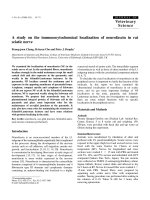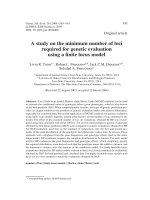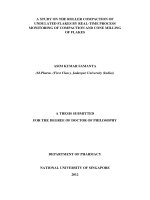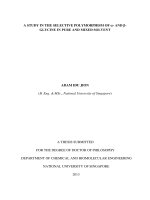A study on the roller compaction of undulated flakes by real time process monitoring of compaction and cone milling of flakes
Bạn đang xem bản rút gọn của tài liệu. Xem và tải ngay bản đầy đủ của tài liệu tại đây (6.58 MB, 177 trang )
A STUDY ON THE ROLLER COMPACTION OF
UNDULATED FLAKES BY REAL-TIME PROCESS
MONITORING OF COMPACTION AND CONE MILLING
OF FLAKES
ASIM KUMAR SAMANTA
(M.Pharm. (First Class), Jadavpur University (India))
A THESIS SUBMITTED
FOR THE DEGREE OF DOCTOR OF PHILOSOPHY
DEPARTMENT OF PHARMACY
NATIONAL UNIVERSITY OF SINGAPORE
2012
2
i
ACKNOWLEDGEMENTS
I wish to express my deepest and most sincere appreciation to my supervisors,
Associate Professor Paul Heng Wan Sia and Dr. Lawrence Ka-Yun Ng
(Center for Scientific Review, National Institutes of Health, USA), for their
patience and advice throughout the course of my research work. They have
shared with me their invaluable experiences and it has definitely enriched my
professional and personal life.
I wish to thank Professor Lucy Wan, Associate Professor Chan Lai Wah and
Assistant Professor Celine Valeria Liew for their invaluable advice in life and
research.
I would specially like to thank Head of the Department of Pharmacy and
National University of Singapore for providing the facilities and research
scholarship, respectively. Thanks to Mrs Teresa Ang and Ms Wong Mei Yin
for their help in providing technical assistance whenever needed.
My stay in NUS would not be as enjoyable and enriching if not for the
wonderful company and help from all friends in GEA-NUS Pharmaceutical
Processing Research Laboratory, especially Sze Nam, Likun and Atul.
Last but not least, I am truly appreciative of my parents, new parents (father-
and mother-in-law) and relatives for their love, blessings, continuous support
and encouragement. Special thanks to my wife Neelam for her help, patience
and mental support. Thank you.
Asim Kumar Samanta
January 2012
ii
Dedication
To my late father Kalipada Samanta.
His words of inspiration and encouragement
in pursuit of excellence, still linger on.
iii
TABLE OF CONTENTS
ACKNOWLEDGEMENTS………………… … …….……… i
TABLE OF CONTENTS……………………………… … … …… iii
SUMMARY………………………… ………… ………………… ix
LIST OF TABLES………………………… ………… …………… x
LIST OF FIGURES………………………… …… ……………… xi
LIST OF SYMBOLS AND ABBREVIATIONS……… ……… xvi
1 INTRODUCTION 1
1.1 Roller compaction 1
1.1.1 Factors affecting roller compaction process 3
1.1.1.1 Raw material properties 3
1.1.1.2 Roller compactor design 4
1.1.1.3 Processing variables 8
1.1.2 Critical quality attributes (CQA) of roller compacted flakes 12
1.1.2.1 Relative density 12
1.1.2.2 Tensile strength 14
1.1.3 Why there is need to monitor CQA of roller compacted flakes? 15
1.1.4 Monitoring of roller compaction process and formulation variable 15
1.1.4.1 Near infrared (NIR) spectroscopy 17
1.1.4.2 Application of NIR spectroscopy 25
1.2 Comminution of roller compacted flakes 26
1.2.1 Forces involved in size reduction 26
1.2.2 Factors affecting the comminution process 29
iv
1.2.2.1 Equipment type and flake property 29
1.2.2.2 Process parameters 31
1.2.3 Evaluation of comminution process parameters 32
1.2.3.1 Significance of granule size, size distribution, and amount of
fines 32
1.2.3.2 Energy requirement for milling 34
1.2.3.3 Milling rate 35
1.3 Research gaps 35
1.3.1 Real-time NIR monitoring of undulated roller compacted flake and
post-milled granule attributes 35
1.3.2 Conical screen milling of undulated roller compacted flakes 37
2 HYPOTHESES AND OBJECTIVES 39
2.1 Hypotheses 39
2.2 Objectives 41
3 EXPERIMENTAL 42
3.1 Study I: Investigation of the factors affecting NIR real-time
monitoring of content uniformity and flake attributes of undulated
roller compacted flakes 42
3.1.1 Materials 42
3.1.2 Methods 42
3.1.2.1 Powder blending 42
3.1.2.2 Roller compaction of powder blends 43
v
3.1.2.3 Flake density measurement 44
3.1.2.4 Flake strength measurement 45
3.1.2.5 Flake thickness measurement ……… ….… …………… 46
3.1.2.6 NIR spectroscopy 46
3.1.2.7 Off-line NIR monitoring set-up 48
3.1.2.8 Calibration model development from the off-line NIR spectral
data 50
3.1.2.9 Validation of the calibration models 50
3.1.2.10 Real-time monitoring set-up 51
3.1.2.11 Real-time monitoring using online Unscrambler Predictor
(OLUP) software …………………………………………… 52
3.2 Study II: Selection of the cone milling process parameters for the
comminution of undulated roller compacted flakes by adopting
minimal fines, milling energy and higher milling rate approach 53
3.2.1 Materials 53
3.2.2 Methods 54
3.2.2.1 Powder blending 54
3.2.2.2 Roller compaction of powder blend 54
3.2.2.3 Comminution of flakes 54
3.2.2.4 Energy consumption 58
3.2.2.5 Milling rate 60
3.2.2.6 Characterization of granules 61
vi
3.3 Study III: Real-time monitoring of post-milled granule attributes,
milling energy and milling time 61
3.3.1 Comminution of flakes 61
3.3.2 Energy consumption 62
3.3.3 Milling rate 62
3.3.4 Characterization of granules 62
3.3.5 Calibration model development 62
3.3.6 Validation of calibration models 63
3.3.7 Real-time analysis of post-milled granule attributes, effective
specific milling energy and milling time 63
4 RESULTS AND DISCUSSION 64
4.1 Study I: Investigation of the factors affecting NIR real-time
monitoring of content uniformity and flake attributes of undulated
roller compacted flakes 64
4.1.1 Flake properties 64
4.1.2 Linear effective surface area scanned by different NIR probe 70
4.1.3 Effect of sampling mode on NIR spectral feature and calibration
models 71
4.1.4 Effect of pre-processing method on calibration models 79
4.1.5 Effect of probe position on calibration models 80
4.1.6 Effect of probe diameter (spot size) on calibration models 84
4.1.7 Selection of best calibration models for real-time analysis 86
4.1.8 Application of best calibration models for real-time roller
compaction process analysis 90
vii
4.1.8.1 System performance of real-time application 90
4.1.8.2 Real-time analysis of flakes 90
4.1.9 Continuous quality monitoring of the roller compaction process 95
4.2 Study II: Selection of the cone milling process parameters for the
comminution of undulated roller compacted flakes by adopting
minimal fines, milling energy and higher milling rate approach 96
4.2.1 Preliminary studies and results 96
4.2.2 Effect of impeller sidearm shapes and screen types on the granules
size and size distribution at different impeller speeds 98
4.2.3 Effect of impeller speeds and types with different screens on the
percentage of fines generated during milling 106
4.2.4 Cone mill no-load power requirement 111
4.2.5 Effect of impeller speed, screen type and impeller type on total
specific energy …………………………………………………111
4.2.6 Effect of speed, screen type and impeller type on effective specific
energy…………………………………………………………….115
4.2.7 Effect of screen type, impeller type and impeller speed on milling
rate 117
4.3 Study III: Real-time monitoring of post-milled granule
characteristics, milling energy and milling time 120
4.3.1 Post-milled granule size, size distribution and fines 120
4.3.2 Effect of drug concentration and RF on total and effective specific
milling energy ……………………………………………………126
4.3.3 Effect of drug concentration and RF on milling rate 129
viii
4.3.4 Validation of the calibration models 131
4.3.5 Real-time analysis 136
5 CONCLUSIONS 139
6 REFERENCES 144
7 LIST OF PUBLICATIONS 156
ix
SUMMARY
NIR spectroscopy has already been exploited for real-time monitoring of
critical quality attributes of smooth roller compacted flakes. However, there
has been no reported research undertaken on the undulated flakes.
Furthermore, the comminution of flakes which has enormous impact on
manufacturing of finished dosage forms has also not been well studied. The
first section of this study was directed at assessing the use of NIR
spectroscopy for the real-time process monitoring of undulated flakes
production. It was shown that NIR spectroscopy could successfully monitor
content uniformity and critical quality attributes (tensile strength, Young’s
modulus and relative density) of undulated flakes by appropriate selection of
spectral acquisition mode, NIR probe positioning, spectral preprocessing
method and beam size. In the second section of the study, the cone milling
process for undulated roller compacted flakes was studied. Impeller sidearm
shape, screen surface profile and impeller speed showed significant influence
on granule attributes, fines generated, energy consumed and milling rate. A
study on the applicability NIR real-time monitoring for the prediction of the
post-milled granule attributes, percent fines, energy consumption and milling
rate was also carried out. Real-time NIR predicted data suggested that granule
attributes could be successfully predicted with a high level of accuracy in an
efficient and non-destructive manner. Overall, findings from this project study
serve as a step forward towards achieving the objectives using process
analytical technologies to advance the quality-by design (QbD) approach in
pharmaceutical production.
x
LIST OF TABLES
Table 1: Forces involved in particle size reduction 28
Table 2: Composition of materials in formulations studied. 43
Table 3: Screen and spacer bushing specifications of smooth screen 58
Table 4: Screen and spacer bushing specifications of grater screen 58
Table 5: Summary of the figures of merits obtained for calibration models
based on SNV followed by 1
st
derivative pretreated spectra in static
mode 75
Table 6: Summary of the figures of merits obtained for calibration models
based on SNV followed by 1
st
derivative pretreated spectra in
dynamic mode 76
Table 7: Summary of the figures of merits obtained for calibration models
based on SNV followed by 2
nd
derivative pretreated spectra in static
mode 77
Table 8: Summary of the figures of merits obtained for calibration models
based on SNV followed by 2
nd
derivative pretreated spectra in
dynamic mode 78
Table 9: Standard deviations of prediction results from test set sample. NIR
spectra collected from the under side of the flakes 86
Table 10: Validation results obtained with test set. Validation results of TS, E
and RD on flakes containing 4 %, w/w µCPM. 87
Table 11: Screen and spacer bushing specifications of smooth screen 98
Table 12: Screen and spacer bushing specifications of grater screen 98
Table 13: d
10
and d
90
values of granules from smooth screen under different
milling conditions .…………………… …………… 104
Table 14: d
10
and d
90
values of granules from grater screen under different
milling conditions 105
Table 15: Combinations of impeller and screen in different mill setting 109
Table 16: Leave one out full cross validation (FCV) and test set validation
(TSV) results of post-milled granule attributes (MMD and fines),
E
e
and milling rate of flakes containing 6 % µCPM …………135
xi
LIST OF FIGURES
Figure 1: Roll orientations. (a) horizontal; (b) inclined; (c) vertical (Guigon
and Simon, 2003) 5
Figure 2: Roll surfaces (a) smooth roll; (b) corrugated; (c) fluted (modified
from Pietsch (1991)) 7
Figure 3: Stress-strain relationship in particle size reduction 28
Figure 4: Three point beam bending test method: (A) experimental set-up and
(B) schematic diagram 47
Figure 5: Reflection probe (A) with optical head (B) showing 6 illumination
fibres around the central read fibre 47
Figure 6: Schematic diagram of NIR off-line set-up for spectral acquisition
from the upper side of the flakes (A) and the under side of the flakes
(B) 49
Figure 7: Schematic diagram of in-line NIR monitoring set-up for real-time
roller compaction process 52
Figure 8: Cross-sectional view of impeller sidearms along with the position of
screen and direction of impeller rotation 55
Figure 9: Surface profile of screens: (A) smooth and (B) grater 55
Figure 10: (A) Planar view of the impeller-conical screen set-up and (B)
schematic diagram of the Quadro Comil 197S indicating the use of
spacer bushing to adjust impeller-screen distance. 57
Figure 11: Effect of changing µCPM concentration and RF on RD of
undulated flakes prepared according to the 5
2
full factorial
experimental design 66
Figure 12: Effect of changing µCPM concentration and RF on TS of undulated
flakes prepared according to the 5
2
full factorial experimental
design 67
Figure 13: Effect of changing µCPM concentration and RF on E of undulated
flakes prepared according to the 5
2
full factorial experimental
design 68
Figure 14: PCA of process parameter, formulation parameter and flake
properties in correlation loadings plot 69
xii
Figure 15: Scanning electron photo micrograph depicting adhesion of µCPM
particles onto a lactose particle 69
Figure 16: Spectral difference observed for the same piece of flake with
dynamic and static sampling strategies. Spectra were captured from
the upper side of the flakes using QR400 probe and pretreated with
SNV followed by 1
st
derivative. In this plot, X and Y axes
represent the wavelength (nm) and absorbance, respectively. 73
Figure 17: Spectral difference observed for the same piece of flake with
dynamic and static sampling strategies. Spectra were captured from
the upper side of the flakes using QR400 probe and pretreated with
SNV followed by 2
nd
derivative. In this plot, X and Y axes
represent the wavelength (nm) and absorbance, respectively. 74
Figure 18: SNV followed by 1st derivative preprocessed NIR reflectance
spectra of flake components in powder form. In this plot, X and Y
axes represent the wavelength and absorbance, respectively. 81
Figure 19: Raw NIR reflection spectra of calibration batches captured from the
upper side of the flakes using QR 400 NIR probe. In this plot, X
and Y axes represent the wavelength (nm) and absorbance,
respectively. 82
Figure 20: SNV pretreated NIR reflection spectra of calibration batches
captured from the upper side of the flakes using QR 400 NIR
probe. In this plot, X and Y axes represent the wavelength (nm)
and absorbance, respectively. 82
Figure 21: SNV followed by 1st derivative pretreated NIR reflection spectra of
calibration batches captured from the upper side of the flakes using
QR 400 NIR probe. In this plot, X and Y axes represent the
wavelength (nm) and absorbance, respectively. 83
Figure 22: SNV followed by 2nd derivative pretreated NIR reflection spectra
of calibration batches captured from the upper side of the flakes
using QR 400 NIR probe. In this plot, X and Y axes represent the
wavelength (nm) and absorbance, respectively. 83
Figure 23: Thickness of 10 flakes (cm) at different µCPM concentration and
RF 84
Figure 24: NIR-PLS1 regression model for µCPM concentration. Points in
blue colour in the regression plots in the regression plots indicate
the calibration samples and in red colour are test set validation
samples. 88
Figure 25: NIR-PLS1 regression model for RD at 4 % µCPM content. Points
in blue colour in the regression plots in the regression plots indicate
the calibration samples and in red colour are test set validation
samples. 88
xiii
Figure 26: NIR-PLS1 regression model for TS at 4 % µCPM content. Points in
blue colour in the regression plots in the regression plots indicate
the calibration samples and in red colour are test set validation
samples. 89
Figure 27: NIR-PLS1 regression model for E at 4 % µCPM content. Points in
blue colour in the regression plots in the regression plots indicate
the calibration samples and in red colour are test set validation
samples. 89
Figure 28: PLS1 predicted values of µCPM concentration from the NIR data
collected during real-time monitoring of roller compaction. 93
Figure 29: PLS1 predicted values of RD from the NIR data collected during
real-time monitoring of roller compaction. Values determined
using reference method as diamonds. 93
Figure 30: PLS1 predicted values of TS from the NIR data collected during
real-time monitoring of roller compaction. Values determined
using reference method as diamonds. 94
Figure 31: PLS1 predicted values of E from the NIR data collected during
real-time monitoring of roller compaction. Values determined
using reference method as diamonds. 94
Figure 32: RF and vertical feeding screw speed during roller compaction of 4
% µCPM containing powder blend 95
Figure 33: MMD of granules after milling 200 g of flakes at different milling
conditions using 2388 μm aperture size screen 99
Figure 34: Size reduction mechanisms of different impellers 102
Figure 35: Span of granules after milling 200 g of flakes at different milling
conditions using 2388 μm aperture size screen 103
Figure 36: Percent fines produced after milling 200 g of flakes at different
milling conditions using 2388 μm aperture size screen 108
Figure 37: Relation between fines and MMD of the granules at different mill
settings 110
Figure 38: No-load power demand of conical screen mill with impeller speed
111
Figure 39: Total specific energies (E
t
) for I-1, I-2, I-3, I-4 and I-5 with grater
and smooth screens at various impeller speeds. 114
Figure 40: Force involved in cone milling process 115
Figure 41: Effective specific energies (E
e
) of I-1, I-2, I-3, I-4 and I-5 with
smooth screen at various impeller speeds 116
xiv
Figure 42: Effective specific energies (E
e
) of I-1, I-2, I-3, I-4 and I-5 with
grater screen at various impeller speeds 117
Figure 43: Cumulative weights of milled granules for different milling studies
plotted against milling time …………… …………… 119
Figure 44: Effect of screen and impeller type on milling rate of flakes at
various impeller speeds 119
Figure 45: PCA analysis of process parameter, formulation parameter and
granules properties in correlation loadings plot …………… 122
Figure 46: Variation in the MMD of the post-milled granules resulted from the
0 %, 2 %, 4 %, 6 % and 8 % µCPM containing flakes at different
RF…… … 123
Figure 47: Variation in the span of the post-milled granules prepared from the
0 %, 2 %, 4 %, 6 % and 8 % µCPM containing flakes at different
RF 124
Figure 48: Variation in the percent fines of the post-milled granules prepared
from the 0 %, 2 %, 4 %, 6 % and 8 % µCPM containing flakes at
different RF 125
Figure 49: Variation in the E
t
required to mill 0 %, 2 %, 4 %, 6 % and 8 %
µCPM containing flakes compacted at different RF 127
Figure 50: Variation in the E
e
required to mill 0 %, 2 %, 4 %, 6 % and 8 %
µCPM containing flakes compacted at different RF 128
Figure 51: PCA analysis of roller compaction process and formulation
parameters, E
t
, E
e
and milling rate of flakes in correlation loadings
plot 129
Figure 52: Cumulative weights of milled granules for different milling studies
plotted against milling time. 130
Figure 53: Variation in the milling rate during milling of 0 %, 2 %, 4 %, 6 %
and 8 % µCPM containing flakes compacted at different RF 131
Figure 54: NIR-PLS1 regression model for MMD at 6 % µCPM content.
Points in blue colour in the regression plot indicate the calibration
samples and in red colour are test set. 133
Figure 55: NIR-PLS1 regression model for fines at 6 % µCPM content. Points
in blue colour in the regression plot indicate the calibration samples
and in red colour are test set. 133
Figure 56: NIR-PLS1 regression model for E
e
at 6 % µCPM content. Points in
blue colour in the regression plot indicate the calibration samples
and in red colour are test set. 134
xv
Figure 57: NIR-PLS1 regression model for milling rate at 6 % µCPM content.
Points in blue colour in the regression plot indicate the calibration
samples and in red colour are test set. 134
Figure 58: PLS1 predicted values of MMD from the NIR data collected during
real-time monitoring of roller compaction. Values determined
using reference method as diamonds … ……….137
Figure 59: PLS1 predicted values of fines from the NIR data collected during
real-time monitoring of roller compaction. Values determined
using reference method as diamonds. 137
Figure 60: PLS1 predicted values of E
e
from the NIR data collected during
real-time monitoring of roller compaction. Values determined
using reference method as diamonds. 138
Figure 61: PLS1 predicted values of milling rate from the NIR data collected
during real-time monitoring of roller compaction. Values
determined using reference method as diamonds. 138
xvi
LIST OF SYMBOLS AND ABBREVIATIONS
ºC
Degree Celsius
∆P
t
Effective power consumption
µCPM
Micronized Chlorpheniramine maleate
µm
Micrometer
φ
Phase angle
ρ
T
True density of powder
ρ
blend
T
True density of powder blend
A
Ampere
ANOVA
Analysis of variance
API
Active pharmaceutical ingredient
ARE
Acoustic relaxation emission
ASTM
American society of testing and materials
b
Width of flake
CQA
Critical quality attributes
d
10
Particle size at the 10
th
percentile of the cumulative percent
weight undersize chart
d
50
Particle size at the 50
th
percentile of the cumulative percent
weight undersize chart
d
90
Particle size at the 90
th
percentile of the cumulative percent
weight undersize chart
DoE
Design of experiment
E
Young’s modulus
E
e
Effective specific energy
xvii
E
t
Total specific energy
ED
Envelope density
FCV
Full cross validation
FDA
Food and Drug Administration
FFT
Fast fourier transform
h
Thickness of flake
IBC
Intermediate bulk container
J
Joule
kN
Kilonewton
kPa
Kilopascal
KNN
K nearest neighbours
L
Support span in 3 point beam bending test
LDA
Linear discriminant analysis
m
Mass
MCC
Microcrystalline cellulose
MgSt
Magnesium stearate
MLR
Multiple linear regression
MMD
Mass median diameter
MPa
Megapascal
MSC
Multiplicative scatter correction
N
Rpm
n
Porosity
NIR
Near infrared
OLUP
Online Unscramble predictor
P
�
0
No load power requirement
xviii
P
t
Power consumption at time t
P
Load
PAT
Process analytical technology
PC
Principal component
PCA
Principal component analysis
PCR
Principal component regression
PLS
Partial least square regression
QbD
Quality by design
QDA
Quadratic discriminant analysis
R
2
Correlation coefficient
RD
Relative density
RF
Roll force
RH
Relative humidity
RMSEC
Root mean square error of calibration
RMSECV
Root mean square error of cross validation
RMSEP
Root mean square error of validation
rpm
Revolution per minute
RS
Roll speed
S
d
50
Span
SD
Standard deviation
SEP
Square error of prediction
SIMCA
Soft independent modeling of class analogies
SNV
Standard normal variate
TS
Tensile strength
TSV
Test set validation
xix
UV
Ultraviolet
V
e
Apparent volume
V
Voltage
w/w
Weight by weight
W
Watt
Wh
Watt hour
y
Deflection of load point in 3 point beam bending test
1
1 INTRODUCTION
1.1 Roller compaction
Roller compaction is an agglomeration process where the powder is densified
between two counter rotating rolls by the application of mechanical pressure
as powder passes through the rolls (Inghelbrecht and Remon, 1998a; Murray
et al., 1998). The friction between roll surfaces and feed material drags the
powder into the narrow space between the two counter rotating rolls where the
feed powder is subjected to great pressure. As the pressure goes up further, the
particles deform, fragment and bond together to form compacted flakes. The
roll’s surfaces may be smooth, fluted or knurled and feed material will be
compacted into dense sheet-like strip or often referred as ribbon-like flakes. If
the roll’s surface contains pockets, then the compacted material will be
presented as dense briquettes of almond shape or stick-like. The path through
which feed material passes during roller compaction can be sub-divided into
three zones: (a) feeding zone, where the stress is moderate and densification is
solely due to rearrangement of particles; (b) compaction zone, where the
pressing force becomes effective and the particle deform plastically and/or
break; and (c) extrusion zone, where pressure eases and compact is released.
The boundary between the feeding zone and the compaction zone to the mid-
point between the rolls is called the nip or gripping angle (Guigon and Simon,
2003). Nip angle size is mainly affected by two key factors, namely, surface
friction and the internal friction (friction of material). Highly compressible
materials tend to have large nip angles (~30
0
) whereas poorly or
incompressible materials have smaller nip angles (~7-10
0
).
2
Roller compaction as a dry granulation process has been widely used in many
industries since the end of the 19
th
century. Although roller compaction has
been used in the pharmaceutical industry for more than 50 years, it has
recently drawn more attention because of some limitations with wet
granulation and need to improve manufacturing efficiencies. A number of new
active pharmaceutical ingredients (API) cannot be formulated easily by wet
granulation and the need to dry granulation because of their moisture and heat
sensitivities. Therefore, such APIs require the use of dry granulation processes
to ensure the production of stable solid dosage forms (Miller and Sheskey,
2007).
Roller compaction is a simple, continuous and relatively inexpensive process
that does not require any wetting and drying steps. It is environmentally
friendly and especially attractive for heat, moisture and solvent sensitive
drugs. In addition, formulations containing high concentrations of hydrophilic
polymers can be granulated by roller compaction with much less complexity
or challenges (Sheskey et al., 1994). It is easily scalable, allows continuous
manufacturing and has relatively low operational and maintenance costs.
Roller compaction has been employed to improve the flow characteristics of
powders for tabletting and capsule filling (Miller and Sheskey, 2007). It is a
useful alternative to wet granulation process as it excludes the possible
degradation caused by heat or moisture associated with the wet granulation
process, thus ensuring product stability. It is also useful for the enhancement
of dissolution properties of sparingly water soluble drugs (Mitchell et al.,
2003). In some cases, the capping tendency of tablet may also be reduced.
3
Dust problems are minimized and the die filling during tabletting is improved
by the use of roller compacted granules instead of powders. Lastly, the bulk
density of powders can be increased by roller compaction, thereby improving
material handling and transport by minimizing the overall bulk volume.
1.1.1 Factors affecting roller compaction process
The fundamental mechanisms of roller compaction are complex, and like other
manufacturing processes, product quality and performance depend upon raw
material properties, equipment design and process variables
1.1.1.1 Raw material properties
Raw material properties such as particle size and shape have been reported to
affect the compaction properties of the flakes, post-milled granule particle size
distribution, flowability and compaction properties of the tablets (Bacher et
al., 2007; Bacher et al., 2008). Studies have shown that fine particles are more
compactable than coarse particles. However, the effect of particles size on
compaction properties depends on the type of material. The compaction
properties of plastic materials are more likely to change with particle size than
brittle materials (Tye et al., 2005; Wu and Sun, 2007). This effect can be best
explained by particle bonding theory. In roller compaction process, particles
undergo rearrangement, deformation, fragmentation, and bonding. At high
pressure, plastic materials like microcrystalline cellulose (MCC) deform and
bond without propagating extensive crack. Larger plastic granules have less
surface area available for bonding, leading to the production of tablets with
lower tensile strength (Sun and Himmelspach, 2006). In roller compaction,
MCC also loses its compactibility after repeated compaction, possibly due to
granule size enlargement. Therefore, tableting properties of these granules
4
were determined by size and surface properties of the granules but not by
those of the original MCC particles. On the other hand, brittle materials under
high pressure fragment to create new surfaces for bonding. Thus, the
tabletability of the brittle granules produced by roller compaction is relatively
insensitive to granule size enlargement (Wu and Sun, 2007). However,
Riepma et al. (1993) reported that the type of lactose and the granule size had
an impact on the granule compactibility.
Selection of proper size and morphological form of particles is important to
control the flowability and mechanical strength of tablets. Inghelbrecht and
Remon (1998b) studied the influence of lactose particle morphology on the
properties of granules produced by roller compaction and they found a
relationship between these two. Bacher et al. (2007) reported that an ideal
morphological form of calcium carbonate improved the flowability of granules
and produced tablets of acceptable mechanical strength. In another study,
Herting and Kleinebudde (2007) showed that small sized microcrystalline
cellulose and theophylline particles improved flowability of granules and
increased tensile strength of tablets made from such powders and granules.
1.1.1.2 Roller compactor design
There are several factors to consider in roller compactor selection, such as the
roll design, the roll surface and the feeder design. Over the years, much
attention had been directed at the roller compactor design to improve overall
of compaction efficiency.









